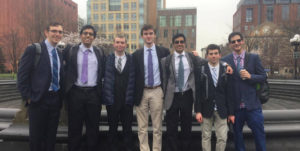Guest article by Nicholas Hartunian, the chief strategy officer of UConn TMUN.
The University of Connecticut has historically had an International Relations Club that met weekly to discuss world affairs. This group went to one Model United Nations conference a year.
Spring semester of 2017, ambitious freshmen and sophomores were elected to every officer position and rewrote the constitution. The International Relations Club was transformed into the Travel Model United Nations Team.
UConn Travel MUN is currently in the academic year following this dramatic change and has:
- Gone from one MUN conference a year to seven.
- Gone from winning roughly one award a year to nine (and there are still three conferences left).
- Developed a stable form of club government that has effectively managed long-distance events like McMUN.
During this three semester sprint towards success, the University of Connecticut has taken to heart three non-obvious lessons about running a collegiate MUN team that worked for us:
- Don’t pitch at club fairs. Have a conversation.
Speaking as two-year president of my high school club, I used to give pitches about MUN to anyone who would stop at our table during the annual club fair. Embarrassingly, I could pitch 40 times and not earn a single new member for my organization.
In response, I would tweak the pitch and try to make it more persuasive. I was an award winning public speaker; what could I be doing wrong? Interestingly enough, I found the answer watching sales training videos on YouTube.
A tailored pitch will always be more effective than a generic one, and a dialogue will always be more effective than a monologue.
Here’s how I applied these two ideas in college:
Start talking to someone at your club fair table by asking what major they are. Business majors want to hear more about the public speaking, negotiating, and networking skills they’ll build in MUN, while political science and history majors want to hear more about how MUN brings diplomacy scenarios to life. Like anything resembling stereotyping, these categories are not perfect, and it’s your duty to figure out what someone is most interested in. The next step is easy: highlight that piece of Model UN!
That said, the above is not an excuse to just ask one question and then pitch. Talking with someone is far more effective than talking at someone.
The key to blending a tailored pitch with a conversation is to ask questions and give the other person space to talk. If someone’s ears perks up when you say the word “networking,” ask if they have a story about a networking experience. Don’t be afraid to completely go off topic from your club for a few minutes and just casually talk.
Eventually tie the conversation back to why MUN is a good fit based on what they said, but don’t be abrupt. Occasionally, I make the offense of politely nodding while someone talks and then immediately going back to a pitch.
UConn is a school with over 600 student organizations and having conversations with people at club fairs instead of giving monologues is how we’ve stood out.

UConn Spring Involvement Fair 2018
- President, VP, Secretary, and Treasurer do not always work well for MUN teams.
Face it, students in Model UN are ambitious. Having half your team members hold dreams of the coveted title of “president” and form internal alliances may not be the healthiest environment for this organization. Based on what we’ve seen as a completely student-run organization, it’s not even a natural split of responsibilities.
UConn Travel MUN has found it more effective to run like a business. The TMUN Executive Board consists of three equal voting members and a secretary. In broad terms, the three members are:
- Chief Operating Officer – organizes trips, navigates university bureaucracy, and manages secretary.
- Chief Strategy Officer – runs practice conferences, develops training curriculum, and directs marketing.
- Chief Financial Officer – oversees income and expenditures, stewards club accounts, and writes university funding requests.
Making each of the board members equal can be more organic than a typical presidential hierarchy given that they equally divide the enormous quantity of work associated with running a competitive MUN organization. Furthermore, the business titles make it clear with us that these are not Common-App sinecures but rather positions with extreme responsibility.
To help with their duties, officers are allowed to appoint other club members into their departments based on a competitive application process confirmed by the rest of the board.

NYUMUNC 2017 – the first travel conference organized by our new government.
- Implement a system where people shadow leadership roles.
Membership isn’t as predictable as it was in high school. People study abroad, try to take 20+ credits, and even get jobs and go into the real world. In Spring 2018, TMUN lost two of its three Executive Board members. This could have been a death blow to the club if it were not for the shadowing system.
At the University of Connecticut, if an Exec member knows they may be stepping down, they appoint a “director.” This could be an Strategy Director, Finance Director, or Operations Director (possibly the Secretary). This director’s role is to assist the c-level officer with their current duties and be ready to step up and immediately assume c-level responsibilities if necessary.
In order to compete abroad, you must be stable at home.
Bootstrapping, managing, and watching the success of UConn Travel MUN has been one of the most rewarding experiences of my college career. Different groups will benefit from different strategies, but I hope these hard-earned lessons from UConn help bring a booming MUN team to your university.

Going to BUCS 2018 would not have been possible if there hadn’t been members shadowing the officers who left that semester.

